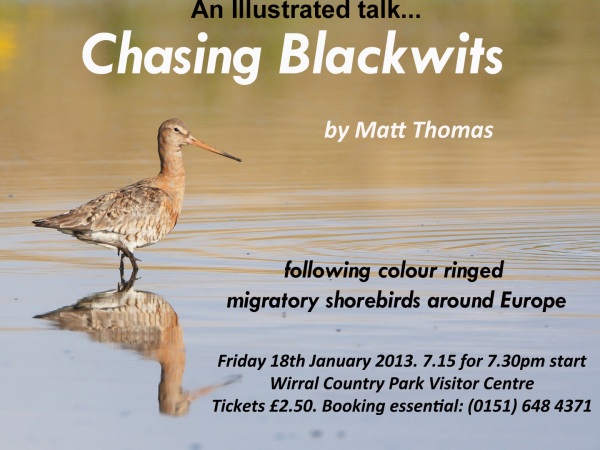Site menu:

December 2012 Newsletter
Wetland Bird Survey 2010/11.
Volunteers wanted for new Point of Ayr Hide.
November Bird News.
Forthcoming Events.
Latest Newsletter.
Wetland Bird Survey 2010/11.
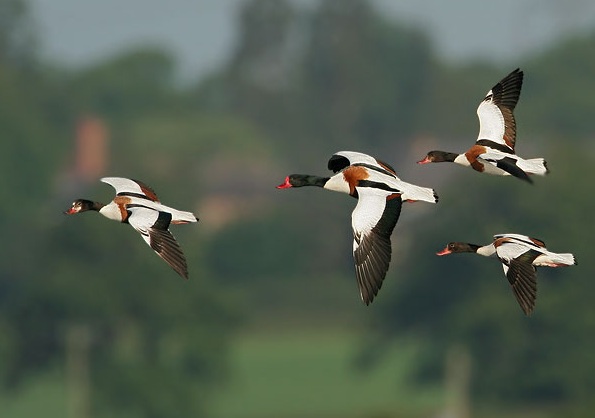
The Wetland Bird Survey Report - Waterbirds in the UK 2010/11 - has
recently been published. It can be read online on the BTO website,
click here:
http://www.bto.org/volunteer-surveys/webs.
The WeBS report always gives us an opportunity to see how the nation's wetland birds are doing and how numbers on the Dee Estuary are changing relative to sites elsewhere in the country. In this article I'm selecting four species in the first half of the Report (Wildfowl/ Divers/ Grebes/Herons) to go into more details and discuss trends, followed by an article next month discussing four species from the second half of the Report (Waders/Gulls/Terns). To clarify, the WeBS 'year' goes from July to June.
Shelduck
In 2010/11 the Dee Estuary had the highest count in the country with 12,234 during October. This was more than twice the next highest count which was 6,081 at Morecambe Bay, a much larger area. Compare that count for the whole of Morecambe Bay with the 8,100 we had on Thurstaston Shore in October 2010, an amazing sight with Dawpool Bank just covered with the birds. There have only ever been three counts higher than 12,234 on the Dee Estuary, in 2003 and 2004 with the max 13,334 in October 2004. We know that since 1995 many Shelduck moult on the nearby Mersey Estuary during July and August rather than flying to the traditional moult site on the Waddensee, more recently it seems likely that some birds have also been moulting on the Dee Estuary. Moulting locally means that numbers build rapidly here during the autumn in contrast to most sites around the country which peak during the winter as birds find their way back from Holland.
Cormorant
Cormorant numbers just keep on increasing on the Dee Estuary. This is in contrast to the national trend where counts have been fairly stable over the past 10 years. Over the past three winters (08/09 to 10/11) counts on the Dee Estuary have even exceeded that from Loughs Neagh and Beg in Northern Ireland and the five year average of 1,204 means we now qualify as a site of International Importance for this species.
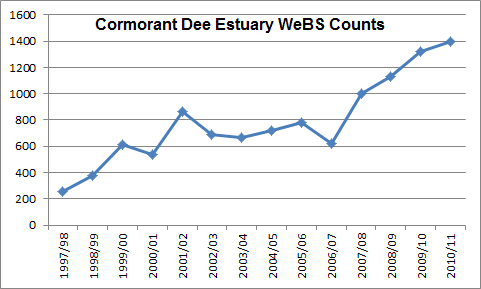
The nearby Alt Estuary usually has similar numbers to the Dee Estuary and in 2010/11 had the largest count with 1,459, almost double the previous winter and the highest ever recorded there. I was amused by the comment in the Report that 'given the proximity of the sites, there may be some degree of exchange of Cormorants between the Dee and Alt Estuaries'. Anybody who bird watches along the north Wirral coast will know this is undoubtedly true with a constant stream of birds flying back and forth between the two sites - something of a distraction when we are looking for rare and exciting sea birds! The WeBS counts, which take place at high tide, don't necessarily record the highest numbers. The largest count ever recorded on the Dee Estuary was a remarkable 2,478 seen from Hilbre on Nov 24th 2009 when almost 1,700 flew out of the estuary at dawn whilst 800 were already on East Hoyle Bank.
Little Egret
Looking back now it seems amazing that it was such a short a time ago as 1996 that Little Egrets were first recorded breeding in this country, and that the maximum counted for WeBS that year was only 502. After 1996 there was a massive increase in numbers so that by 2007 the max WeBS national count had reached 3,900 after which numbers have increased more slowly with 4,423 in 2010/11.

This increase took place almost wholly along the south coast of England and Wales with three noticeable exceptions - The Wash, Lavan Sands (just east of Bangor in North Wales) and the Dee Estuary. On the Dee Estuary there was little increase in numbers until 2001 when there was a count of 18 compared to just six the previous year. The graph above neatly demonstrates that numbers then started to increase at a much faster rate than most of the other sites and by 2005/06 the Dee Estuary was the seventh most important site with a count of 112 and by 2010/11 we are now the third most important site in the country with a count of 303. Birds breed at Burton producing around 80 young a year, and colour ringing has shown we also get many young flying here from the colony at Penrhyn (near Lavan Sands), so it is hardly surprising that numbers continue to increase here. Incidentally, numbers on the Wash (a much larger area than the Dee Estuary, of course), increased from just five in 2000/01 to 543 in 2010/11, making it the most important site in the country.
Great Crested Grebe
It was only in 2006 that it was
realised that there was a resident flock of several hundred Great
Crested Grebes off North Wirral and regular counts started.
Consequently counts for the Dee Estuary WeBS area have increased from
just 33 in 2005/06 to a
remarkable 1,195 in 2010/11. That latter count was the second
highest in the country. The five year mean stands at 584 but this will
increase as we had a count over 800 last winter and already a
count over 900 this winter. For more
details about the North Wirral Great Crested Grebes see the December 2010 Newsletter.

Sources of Information for this article:
The Annual WeBS Reports produced by BTO have been consulted extensively over the time period mentioned in the article. See http://www.bto.org/volunteer-surveys/webs.
Also see:
1. Richard Smith, Species Spotlight - Little Egret, Dee Estuary Website April 2004 (click here).
2. Richard Smith, Great Crested Grebes off North Wirral, Dee Estuary Website December 2010 (click here).
WeBS (Wetland Bird Survey) data in this article should not be used elsewhere in any way without permission of the WeBS Office. To access official WeBS data please contact the WeBS Secretariat - BTO, The Nunnery, Thetford, Norfolk IP 24 2 PU www.bto.org.
Please note that BTO are
currently looking for WeBS counters for the Mersey Estuary.
If you are
interested please contact them, details on:
http://www.bto.org/volunteer-surveys/webs/about/contact-webs.
Top of Page
Volunteers Wanted for New Point of Ayr Hide
The hide, on the Dee Estuary, replaces the original which sadly had to be demolished in 2008 due to excessive and mindless vandalism. But nature lovers will once again be able to enjoy the sights and sounds the reserve has to offer, and the RSPB is inviting people to help celebrate its launch with a free open day on Saturday 3rd November.
Austin Morley, a volunteer at RSPB Dee Estuary said: “It was a huge shame when the old hide was damaged beyond repair. We really hope people will come forward to help us keep the new hide in prime condition and preserve it for future generations.”
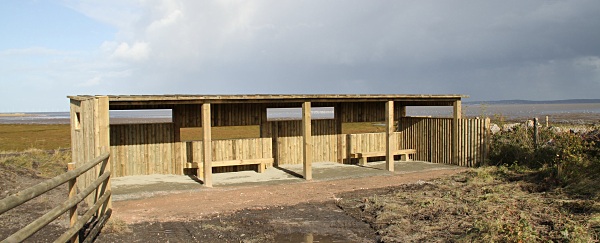
Also see video shot in and around the hide - Click Here.
During the celebration day there will be a free guided walk (starting at 10am), followed by an official opening ceremony. Geoffrey Robinson, RSPB Assistant Warden, said: “It’s always really satisfying to see people of all ages getting close to nature and seeing wildlife they may never have come across before. This new facility will allow exactly that to happen.”
Point of Ayr is accessed off Station Road, in Talacre, and is just 10 minutes from the A548.
For more details or to volunteer to help, email deeestuary@rspb.org.uk or visit www.rspb.org.uk/pointofayr.
Top of Page
November Bird News
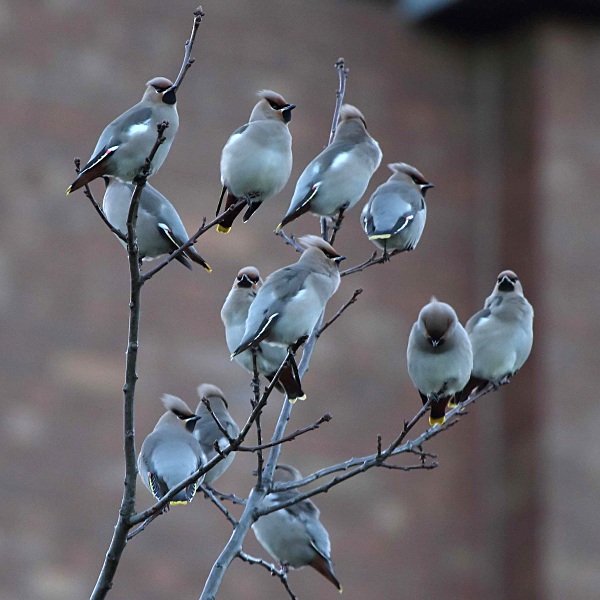
http://keithscovell.blogspot.co.uk/
Waxwings everywhere! It is incredible that we have another large invasion of Waxwings into the country just two years since the last one, and our third in eight years, when normally we would expect such events just once in 20 years. Our first Waxwings arrived with two along Lingham Lane by Leasowe Lighthouse on the 9th. By the 14th they were widespread including 48 at Deeside Industrial Park which increased to over 100 by the 17th. On the same day over 50 were in West Kirby where good numbers remained for the rest of the month although they were often elusive. 51 in Upton on the 22nd was another good count. I'll be writing an article about these birds at the end of the winter.
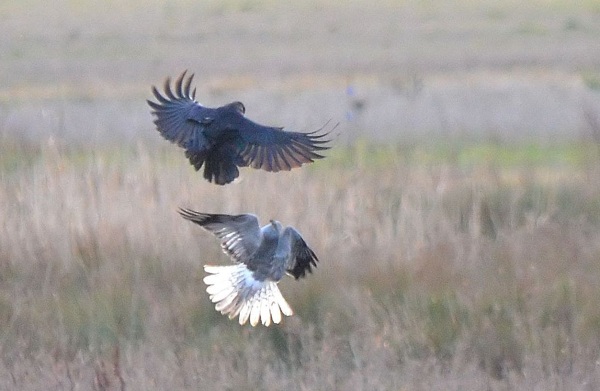
This winter we are lucky to have two grey male Hen Harriers on the marshes, one a sub-adult, and up to three ringtails as well. Those grey males, in particular, are stunning birds.
It's not often that Whinchats feature in the November news but remarkably one was seen and photographed at Inner Marsh Farm on the 21st, even more remarkably it was at Burton Mere Wetlands at the end of the month! Normally the latest record for this species is in the first half of October - but it is not unknown for one or two to overwinter in this country.
Flat calm conditions at the end of the month meant we were able to get a good count of the Great Crested Grebes off North Wirral with 976, the second highest count there and which confirms North Wirral as one of the top three sites in the country for this species.

Knot numbers have been very impressive with between 30,000 and 40,000 in the estuary. The count of 37,000 at the high tide roost at Hoylake on the 19th was the highest there since 50,000 counted in 2001. Similarly, 1,900 Sanderling at Hoylake on the 18th was a very high count and the highest on the Estuary since 2,000 at Hilbre in 2005. Black-tailed Godwits have been feeding in large numbers at Warren Farm, Point of Ayr, with 3,200 there on the 28th. The highest count of Purple Sandpipers were 20 on the pontoon at New Brighton Marine Lake on the 18th.
Other notable records were five Snow Buntings at Point of Ayr and a Black Redstart and Lapland Bunting at Thurstaston.

http://keithscovell.blogspot.co.uk/
What to expect in December
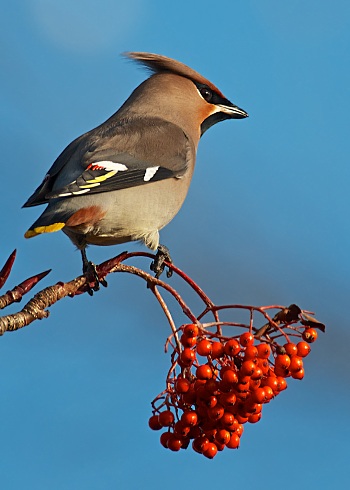 Judging
by previous and recent large
Waxwing invasions we can expect at least as many in December as in
November, so something to look forward to!
Judging
by previous and recent large
Waxwing invasions we can expect at least as many in December as in
November, so something to look forward to!They are forecasting a colder than normal winter but the begining of the month is often marked by southerly gales bringing such goodies as Gannets, skuas and maybe even some Leach's Petrels up from the Bay of Biscay. If we do get cold weather then expect large numbers of waders and a build up of Pink-footed Geese on the marshes and the fields around Burton, hopefully also some White-fronted Geese like last winter. Cold weather movements should include an influx of Woodcocks.
Last winter the highest Brent Geese count was on December 28th with 262 along West Kirby Marsh at high tide, I would be surprised if we didn't get more this year. Look out for a small Scaup flock which are usually somewhere off Hilbre or north Wirral, just off the groyne by Dove Point seems to be a favourite place. Above: Waxwing on Deeside Industrial Estate, Nov 16th © Jeff Cohen.
As well as the geese we should have at least one over-wintering Great White Egret on the marshes. There will also be good views of Short-eared Owls and Hen Harriers, especially during the high tides mid-month including a 10m on the 15th - given a strong west wind that could be spectacular! On the same set of high tides it will be well worth checking out the pontoon on New Brighton Marine Lake where there should be over 20 Purple Sandpipers as well as hundreds of Redshank and Turnstones.
Top of Page
Forthcoming Events
December Highest Spring Tides (Liverpool)
Also
see Tides
page.
14th December, 11.22hrs (GMT), 9.9m.
15th December, 12.11hrs (GMT), 10.0m.
16th December, 12.59hrs (GMT), 9.9m.
Forthcoming Events
Organised by the Wirral
Ranger Service , Flintshire Countryside Service and/or the
RSPB:
All these events and walks have bird interest, even those not
advertised specifically for birdwatching. No need to book for these
events unless specified - please check below.
Also see 2012 Events Diary.
Skydancers at Parkgate - 12 noon until dusk.
Skydancer is an exciting new four-year project aimed at raising awareness and promoting the conservation of hen harriers in the north of England.
The Dee Estuary is a vital wintering ground for these amazing birds and is the best place to see them from October through to March.
Most people have never seen a hen harrier, but once seen it is rarely forgotten. This bird is a beautiful, agile hunter, and its aerobatic sky dances are among the most awesome spectacles in nature.
Unfortunately, with only a handful of pairs still breeding successfully in England, the hen harrier is currently a species on the brink.
Come along to Parkgate to find out more about the hen harrier story and what you can do to help save hen harriers before it's too late!
Look for the RSPB Love Nature marquee along the main promenade at Parkgate where friendly staff and volunteers will be with telescopes and binoculars plus family activities, free information and more: http://www.rspb.org.uk/skydancer/
Directions: The "Donkey Stand" opposite Nicholls Ice-cream shop on The Parade (B5135), Parkgate, Cheshire.
Monday December 3rd, 10th, 17th and 24th. Winter Dusk Walks at Burton Mere Wetlands RSPB.
3pm to 4pm.
The last hour of daylight is a good time to see some interesting wildlife ... hopefully owls, foxes and possibly badgers!
Afterwards we will warm ourselves up in front of the roaring fire of the reception building with a nice hot drink and mince pie.
In addition large roosts of egrets and jackdaws add to the spectacle.
£5 non-RSPB members, £3 RSPB members - 0151 353 8478 or deeestuary@rspb.org.uk.
Saturday December 15th, 9am start.
Estuary Watch: High tide from Heswall Fields.
Join the Rangers at the Thurstaston Visitor Centre for a walk down to the cliff top at Heswall Fields. Here we have a “birds-eye” view over the mudflats and into the creeks that make up the Dee estuary. As the tide rises many thousands of wading birds and ducks will be forced into the open where we can get great views of these special birds.
Warm waterproofs and strong footwear are recommended.
Bring binoculars if you have them. No need to book, meet at the Visitor Centre, Station Road, Thurstaston. CH61 0HN. For more information: (0151) 648 4371.
Saturday December 15th 2 - 3pm
2012 Year of Coast & Countryside in Review - Thurstaston Visitor Centre.
This is a slideshow and talk in the lecture theatre at Wirral Country Park to chart the wildlife seen during the events run by the Rangers as part of Wirral’s Year of Coast & Countryside. It will also give you an idea of where and when to see some great wildlife in 2013.
Places are limited so book early! Call (0151) 648 4371 to reserve a place.
Saturday 12th January, High tide Birdwatch, Hoylake Shore.
9:30 am start. High tide 1113 am, 9.8m.
You will discover why Wirral’s foreshore is an internationally protected site when you join the Dee Estuary Voluntary Wardens, Coastal Rangers and the RSPB on this winter birdwatch at Hoylake. Dress warmly and bring binoculars if you have them.
No need to book.
Meet at King’s Gap, Hoylake.
Please ring (0151) 648 4371 if you need more information.
